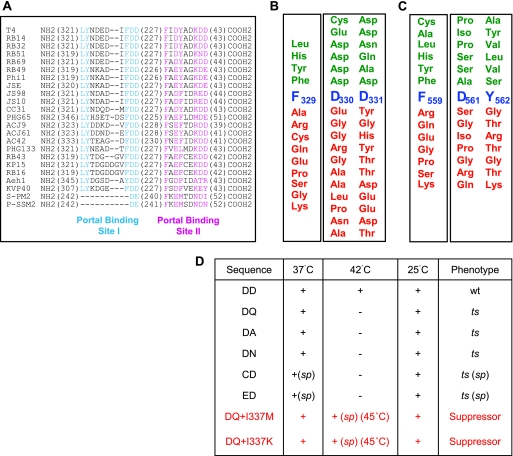Fig 4.
Characterization of a portal binding site in the N-terminal domain of gp17. (A) Sequence alignment of T4 family phage terminases by ClustalW. The numbers in parentheses represent the amino acids that are not shown in the alignment. The conserved residues (>90%) from the putative portal binding sites I and II are highlighted in cyan and magenta, respectively. All sequences were obtained from GenBank. The accession numbers are as follows: T4, P17312; RB14, YP_002854500; RB32, YP_803107; RB51, YP_002854122; RB69, NP 861869; RB49, NP 891724; Phi1, YP_001469498; JSE, YP_002922229; JS98, YP_001595293; JS10, YP_002922510; CC31, YP_004010027; PHG65, YP_004300928; ACJ9, YP_004010314; ACJ61, YP_004009792; AC42, YP_004009538; PHG133, YP_004300751; RB43, YP_238880; KP15, YP_003580049; RB16, YP_003858506; Aeh1, NP 944105; KVP40, NP 899601; S-PM2, YP_195134; and P-SSM2, YP_214360.1. (B) Mutational analysis of conserved residues F329 and DD330-331 of portal binding site I. The importance of F329 for function was analyzed by a suppressor-based genetic approach, and that of DD330-331 was analyzed by a combinatorial approach. Functional substitutions that produced plaques are shown above (green) and null substitutions are shown below (red) the native sequence (blue). (C) Mutational analysis of conserved residues F559 and DY561-562 of portal binding site II. The importance of F559 for function was analyzed by a suppressor-based genetic approach, and that of DY561-562 was analyzed by a combinatorial approach. Coloring is as in panel B. See Materials and Methods for details on the mutagenesis and screening procedures. (D) Functional mutants in portal binding site I were tested for plaque-forming ability at three temperatures: 25°C, 37°C, and 42°C. Each mutant was scored as wt (normal-size plaques), ts (no plaques), or sp (small or minute plaques). “+” means normal plaques, and “−” means no plaques. The phenotypic features of the second site mutant (D331Q) are shown in red.

